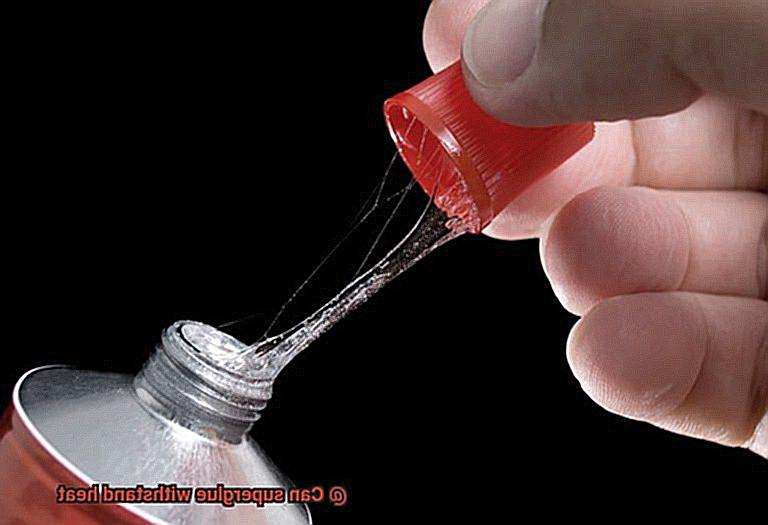We’ve all been there – that gut-wrenching moment when something we cherish shatters into a million pieces. It’s like a punch to the gut, leaving us feeling defeated. But fear not, for superglue has always come to our rescue, swooping in like a superhero to mend our broken treasures. But here’s the burning question: can this trusty adhesive withstand the heat?
Prepare to be amazed, because superglue is tougher than you think when it comes to heat resistance. It’s like a warrior ready to battle any temperature thrown its way. Whether it’s sweltering summer days or blazing hot industrial environments, superglue has proven time and again that it won’t back down.
But hold on tight, because before we dive into the nitty-gritty of superglue’s heat resistance, we need to know its limits. Sure, it can handle some serious heat, but there’s a tipping point where even this mighty adhesive starts to struggle. And let’s not forget about safety precautions – they’re crucial when using superglue in high-heat situations if you want optimal results.
Get ready for an adventure as we uncover the mind-blowing properties of superglue and reveal its potential in conquering the flames. We’ll explore how different industries harness its power and discover mind-boggling formulas that are resistant to scorching temperatures. Brace yourself for an up-close encounter with the unsung hero in our fight against heat – the unbreakable bond of superglue.
So, buckle up and join us on this journey as we unravel the secrets of sup
Heat Resistance: What are the Limitations of Superglue?
Contents
- 1 Heat Resistance: What are the Limitations of Superglue?
- 2 Different Brands and Formulations: How Does This Affect Heat Resistance?
- 3 Temperature Range: How Hot Can Superglue Withstand?
- 4 Factors That Influence Heat Resistance: What Else Should You Consider?
- 5 Effects of High Temperatures on Superglue: What Happens When It Gets Too Hot?
- 6 Alternatives to Superglue for High-Temperature Applications: What Are Your Options?
- 7 Epoxy Adhesives: How Do They Compare to Superglue in Terms of Heat Resistance?
- 8 Silicone-Based Adhesives and Industrial Adhesives: Are They Suitable for High-Temperature Applications?
- 9 Conclusion
Superglue, also known as cyanoacrylate adhesive, is a popular choice for bonding materials due to its rapid drying time and robust adhesive properties. However, when it comes to heat resistance, superglue reveals its limitations.
Here, we will delve into the impact of heat on superglue’s performance, exploring its adhesive strength, temperature ranges, and alternative options for enhancing its heat resistance.
The Impact of Heat:
Superglue is not engineered to endure high temperatures and can degrade or lose its adhesive strength when subjected to heat. Typically, most superglues begin to break down or soften at temperatures exceeding 180°F (82°C). At these elevated temperatures, the bond created by superglue weakens considerably, potentially leading to the failure of the adhesive joint.
Factors Influencing Heat Resistance:
Several factors can influence superglue’s resistance to heat, including the type of materials being bonded and the duration of heat exposure. Certain materials transfer heat more rapidly than others, which accelerates the degradation of the adhesive. Additionally, prolonged exposure to moderate heat, such as constant temperatures around 100°F (38°C), can gradually weaken the bond over time.
Alternative Adhesives for High-Temperature Environments:
To ensure reliable bonding in high-temperature environments, it is advisable to consider alternative adhesives specifically designed for superior heat resistance. Epoxy adhesives, silicone-based adhesives, and select industrial adhesives are examples of specialized options that offer higher tolerance to extreme temperatures and are better suited for applications requiring enhanced heat resistance.
Safety Considerations:
Importantly, it must be noted that superglue should never be used in applications where it will be exposed to direct flames or extreme heat sources. Not only can the glue ignite under such conditions, but it may also release toxic fumes, posing a significant safety hazard.
Different Brands and Formulations: How Does This Affect Heat Resistance?
The world of superglue is a fascinating one, my friends. Have you ever wondered why some superglues lose their grip when things start to heat up? Well, fear not, for I am here to shed some light on the intriguing relationship between different brands and formulations of superglue and their heat resistance capabilities. So buckle up and get ready for a thrilling journey through the realm of adhesive superheroes.
Let’s start with the basics: not all superglues are created equal when it comes to heat resistance. The key lies in their chemical composition. Different brands may use variations of cyanoacrylate monomers, which can significantly impact the glue’s ability to withstand high temperatures. It’s like choosing the right superhero for the job.
But fear not, my fellow adhesive enthusiasts, for there is hope. Some superglues are specially formulated to be heat resistant. These magical formulations often contain additives or modifiers that enhance the glue’s ability to withstand heat without losing its adhesive properties. It’s like giving your superglue a superpower.
However, even with these fantastic heat-resistant formulations, there are limits. Yes, my friends, even our adhesive superheroes have their breaking point. While they can handle higher temperatures than regular superglues, they still have a threshold beyond which they will start to degrade or lose their bond strength. But don’t worry; it’s all about finding the right match for your needs.
Now, let’s talk about the different types of superglue because yes, my friends, not all glues are created equal. Gel-based superglues, for example, are known to have better resistance to heat compared to their liquid or thin-viscosity counterparts. The thicker consistency of gel-based superglues allows them to withstand higher temperatures without losing their adhesive powers. It’s like upgrading your glue to superhero status.
But wait, there’s more. It’s not just about the brand and formulation; other factors like surface preparation and application technique can also affect the heat resistance of superglue. So make sure to clean and prepare your surfaces properly and apply the glue evenly for maximum heat resistance capabilities. It’s all about the little details, my friends.
Temperature Range: How Hot Can Superglue Withstand?
Today, we will delve into the temperature range at which superglue can withstand heat and explore its limits. So, get ready to learn about the heat resistance of superglue and discover alternatives for scorching hot applications.
The Temperature Game:
Superglue, also known as cyanoacrylate adhesive, is a versatile adhesive used for bonding various materials. When it comes to heat resistance, different brands and formulations have different capabilities. Generally, most superglues can handle temperatures ranging from -40°F to 180°F (-40°C to 82°C). That’s quite a wide range.
The Weakening Effect of Heat:
However, extreme heat can compromise the strength and durability of superglue bonds. As the temperature rises towards the upper end of the range, the bond created by superglue may weaken and become more prone to failure. This occurs due to thermal degradation, which breaks down the adhesive’s chemical structure when exposed to heat.
The Material Factor:
But wait, there’s more. Different materials have varying thermal expansion coefficients, meaning they expand or contract at different rates with temperature changes. This can further impact the performance of superglue bonds under high temperatures. Thus, it is crucial to consider both the adhesive and the materials being bonded.
Specialized Superheroes:
Fear not. If you need a super strong bond that can withstand high temperatures without breaking a sweat, specialized high-temperature resistant superglues are available. These adhesives contain additives that enhance their ability to withstand heat without compromising bond strength. They’re like superheroes specially trained for extreme heat conditions.

Exploring Alternatives:
What if you require even greater heat resistance? Well, it might be time to consider alternative adhesives. Epoxy and silicone-based adhesives are renowned for their excellent heat resistance properties and can handle even hotter situations. These alternatives are like the superheroes’ sidekicks, ready to step in when the heat is too intense for superglue alone.
Factors That Influence Heat Resistance: What Else Should You Consider?
Superglue is known for its bonding strength, but its resistance to heat can vary depending on several factors. In this article, we will explore the key considerations that impact the heat resistance of superglue. Get ready to uncover the secrets behind selecting an adhesive for high-temperature applications.
Type of Superglue:
Not all superglues are created equal when it comes to heat resistance. Different formulations and brands may have varying capabilities to withstand high temperatures. Verify the heat resistance properties of a superglue by checking the label or product specifications.
Temperature Range:
Heat resistance in adhesives is determined by the temperature range they can withstand without significant degradation or loss of strength. Each type of superglue has different temperature limits, so it is essential to understand the specific heat range in which the glue maintains its integrity.
Duration of Exposure:
The duration of exposure to high temperatures also affects heat resistance. Some superglues may handle short-term exposure but struggle under prolonged heat conditions. Consider both the temperature and duration of heat exposure when evaluating the suitability of a superglue for your application.
Substrate Material:

The material onto which the superglue is applied can influence its heat resistance. Certain materials conduct heat more efficiently, resulting in higher temperatures at the bonding interface. This can weaken the adhesive bond or cause it to fail altogether. Assess the heat resistance of superglue based on the substrate material and its thermal properties.
Application Method:
The way you apply superglue impacts its ability to withstand heat. Proper surface preparation and application technique enhance bond strength and overall heat resistance. Follow manufacturer’s instructions for application and ensure even distribution on bonded surfaces.
Environmental Conditions:
Besides heat, other environmental factors affect superglue’s performance. Humidity, moisture, exposure to chemicals, or solvents can influence heat resistance. Choose a superglue compatible with the specific environmental conditions in which it will be used.
Effects of High Temperatures on Superglue: What Happens When It Gets Too Hot?
Superglue, our go-to adhesive for holding things together, may seem invincible. However, when faced with its arch-nemesis – high temperatures – it undergoes a transformation. In this article, we will delve into the effects of heat on superglue, exploring its molecular structure and adhesive properties. Get ready for a fiery journey as we unravel what happens when superglue gets too hot.
Softening and Loss of Effectiveness:

When the heat rises, superglue starts to feel the burn. High temperatures cause the glue’s molecular structure to break down, resulting in a softer and less effective adhesive. The once mighty bond weakens, making it harder for superglue to hold materials together.
Fluidity and Messy Bonds:
As the temperature soars, superglue can turn into a relentless fluid, defying precision application. It becomes runny and spreads uncontrollably beyond its intended area, turning your project into a sticky nightmare. Uneven or messy bonds are likely to ensue, leaving you in a truly sticky situation.
Decreased Strength and Brittle Bonds:
Heat weakens the molecular structure of superglue, causing a decline in its overall strength. Under stress or pressure, bonds may break or become brittle, jeopardizing your project’s integrity. It’s like witnessing superglue lose its superhero powers in the face of high temperatures.
The Ultimate Adhesive Meltdown:
In extreme cases where superglue encounters intense heat like fires or industrial processes, it can experience a catastrophic meltdown of its adhesive properties. The heat causes the glue to vaporize or decompose entirely, rendering it utterly useless for bonding. It’s a tragic demise for our once-mighty adhesive ally.
Protecting Superglue from Heat:
To preserve the optimal performance of your superglue, store it in a cool and dry place. Shield it from direct sunlight and keep it away from heat sources like radiators or ovens. By safeguarding your superglue from high temperatures, you can ensure its superpowers remain intact and save the day on your projects.
Alternatives to Superglue for High-Temperature Applications: What Are Your Options?
I’m here to spill the beans on some fantastic alternatives that can withstand high temperatures with ease. So, buckle up and let’s dive into the world of heat-resistant adhesives.
First up, we have epoxy resin. This bad boy is a thermosetting polymer that can handle temperatures ranging from 300 to 600 degrees Fahrenheit. Talk about impressive, right? Epoxy resins are known for their strong and durable bond, making them perfect for industries like aerospace, automotive, and electronics.
But if you need something even more heat-resistant, silicone adhesive is your go-to option. These adhesives can handle temperatures up to a sizzling 600 degrees Fahrenheit or even higher. Not only do they excel in heat resistance, but they also maintain their bond even when faced with thermal expansion and contraction. You’ll find silicone adhesives working their magic in automotive engines, industrial ovens, and electronic devices.
For those extreme temperature applications, ceramic adhesive is the ultimate choice. These specially formulated adhesives can brave temperatures up to a mind-boggling 2000 degrees Fahrenheit or more. They are the superheroes of the aerospace, defense, and energy industries, providing unmatched strength and durability in the face of extreme heat.
Now, if you want a quick fix or a temporary solution for your high-temperature needs, consider heat-resistant tapes and films. These babies come with a high-temperature adhesive backing that can withstand temperatures ranging from a few hundred to thousands of degrees Fahrenheit. They’re perfect for insulation purposes, sealing joints in hot environments, or as a temporary solution when traditional adhesives just won’t cut it.
Remember, when choosing an alternative adhesive for high-temperature applications, take into account factors like temperature range, bond strength, flexibility, and durability. And if you’re feeling lost, don’t worry. Seek guidance from adhesive specialists or suppliers who can help you find the perfect adhesive match for your project.
Epoxy Adhesives: How Do They Compare to Superglue in Terms of Heat Resistance?
Today, we embark on a journey into the realm of heat-resistant adhesives, delving into the comparison between epoxy adhesives and superglue in terms of their heat resistance capabilities. Prepare to be captivated by the strength and power of these glues.
Let’s kick things off with epoxy adhesives. These warriors of bonding are renowned for their exceptional heat resistance, making them the top choice for applications that require materials to withstand high temperatures.
The secret lies within their chemical composition and cross-linking structure. When the two components of epoxy adhesive – resin and hardener – combine forces, a chemical reaction ensues, birthing a robust and unyielding adhesive capable of braving temperatures ranging from a blistering 250°F to an astonishing 600°F, depending on the specific formulation.
On the flip side, while superglue reigns supreme when it comes to quick fixes and general bonding, its heat resistance falls short compared to its epoxy counterpart. It can withstand temperatures up to approximately 180°F, which is commendable but pales in comparison to epoxy adhesives.
Now, let’s explore some key distinctions between these two glues:
- Temperature Tolerance: Epoxy adhesives reign supreme in the realm of heat resistance. They can endure scorching temperatures as high as 600°F, while superglue bows out at around 180°F.
- Applications: Epoxy adhesives find their calling in industries such as automotive, electronics, aerospace, and industrial equipment, where high-temperature resilience is paramount. Superglue, on the other hand, thrives in everyday household repairs and bonding endeavors.
- Additional Properties: Epoxy adhesives not only flaunt remarkable heat resistance but also offer exceptional chemical resistance, electrical insulation properties, and mechanical strength. Superglue does not possess these additional attributes.
It is important to note that not all epoxy adhesives are created equal in terms of heat resistance. Different formulations may have varying maximum temperature limits, necessitating the selection of the appropriate epoxy adhesive based on specific temperature requirements.
While epoxy adhesives boast unparalleled heat resistance, they do come with a few caveats. Their application may entail longer curing times and more intricate procedures, such as meticulous resin and hardener mixing in precise ratios and allowing ample time for complete adhesive cure. Conversely, superglue stands as the epitome of simplicity and swiftness for straightforward bonding needs.
Silicone-Based Adhesives and Industrial Adhesives: Are They Suitable for High-Temperature Applications?
Silicone-based adhesives and industrial adhesives are both excellent choices for high-temperature applications. These adhesives are specifically designed to withstand scorching temperatures, making them invaluable in various industries.
Silicone-based adhesives, made from silicone polymers, boast a stable chemical structure that provides exceptional heat resistance. They can endure temperatures ranging from -40°C to 200°C or higher, depending on the formulation. This wide temperature range makes them perfect for bonding materials exposed to extreme heat.
One of the key advantages of silicone-based adhesives is their ability to maintain flexibility and adhesive strength at high temperatures. Unlike other adhesives that may become brittle or lose their bonding capabilities when exposed to heat, silicone-based adhesives remain strong and durable. This makes them ideal for automotive components, electronic devices, and aerospace applications.
In addition to their heat resistance, silicone-based adhesives offer excellent resistance to thermal cycling, moisture, chemicals, and UV radiation. They are engineered to provide long-lasting bonds even under harsh conditions, ensuring reliable performance in high-temperature environments.
It’s important to note that not all silicone-based adhesives are created equal in terms of their heat resistance capabilities. Different formulations and manufacturers may offer varying temperature ranges and performance characteristics. Therefore, it’s crucial to select the appropriate adhesive based on specific application requirements and operating conditions.
So, whether you need to bond components in a car engine or attach electronic devices in extreme temperatures, silicone-based adhesives and industrial adhesives are here to save the day. With their impressive heat resistance properties and strong bonding capabilities, they are the go-to choice for high-temperature applications.
mLayFRQ7jdo” >
Also Read: How Much Weight Can Hot Glue Hold?
Conclusion
Superglue, a popular adhesive known for its strong bond, is often relied upon for various projects. But when it comes to heat resistance, can superglue hold up? The answer lies in understanding its chemical composition and properties.
When exposed to high temperatures, superglue can undergo significant changes. Its ability to withstand heat depends on the specific type of superglue and the temperature it is exposed to. Generally, most standard superglues start to lose their strength and integrity at temperatures above 180°F (82°C).
At elevated temperatures, the bond created by superglue weakens, leading to potential failure or breakage. This is because heat causes the glue’s molecules to become more active and move around, disrupting the adhesive bond.
However, it’s important to note that there are specialized types of superglue designed specifically for high-temperature applications. These heat-resistant variants are formulated with special additives that enhance their ability to withstand extreme temperatures.
For instance, there are certain industrial-grade superglues that can endure temperatures up to 400°F (204°C) without losing their adhesive properties. These heat-resistant adhesives are commonly used in industries such as automotive manufacturing and aerospace engineering.
It’s crucial to select the right type of superglue based on your project’s requirements and the anticipated temperature conditions it will be subjected to. Always check the manufacturer’s specifications and recommendations for guidance.
In conclusion, while standard superglues may not be able to withstand high temperatures effectively, there are specialized variants available that offer excellent heat resistance.
By choosing the appropriate type of superglue for your specific needs, you can ensure a durable and reliable bond even in challenging thermal environments.






